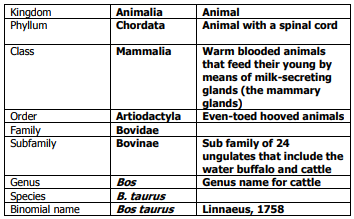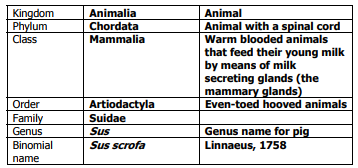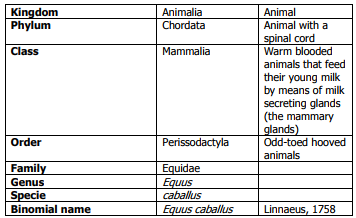The orders of importance for domesticated animals are Perissodactyla (hooved animals with an odd number of toes) and Artiodactyla (hooved animals with an even number of toes).

Horses (family Equidae) and rhinoceroses have an odd number of hooved toes, thus they are Order Perissodactyla.
Pigs (family Suidae), hippopotamus (family Hippotamidae), camels and llamas (family Camelidae), giraffe (family Giraffidae), and cattle (family Bovidae), sheep (family Ovidae), goats (family Capridae) are all hollow-horned ruminants, which belong to the Order Artiodactyla because they have an even number of hooved toes.
The next levels of the taxonomic classification system are Genus and Species. Animals of the same species can interbreed.
Visit: http://en.wikipedia.org/wiki/sheep
Cattle
Cattle were originally identified by Carolus Linnaeus as three separate species. There were Bos Taurus, the European cattle including similar types from Africa and Asia; Bos indicus the zebu; and the extinct Bos primigenius, the aurocks. The aurocks are ancestral to both Zebu and European cattle. More recently these three have increasingly been grouped as one species, sometimes using the name Bos primigenius taurus and Bos primigenius indicus.
Friesian / Holstein Cow
The following illustration shows the full classification of the Holstein Cow.
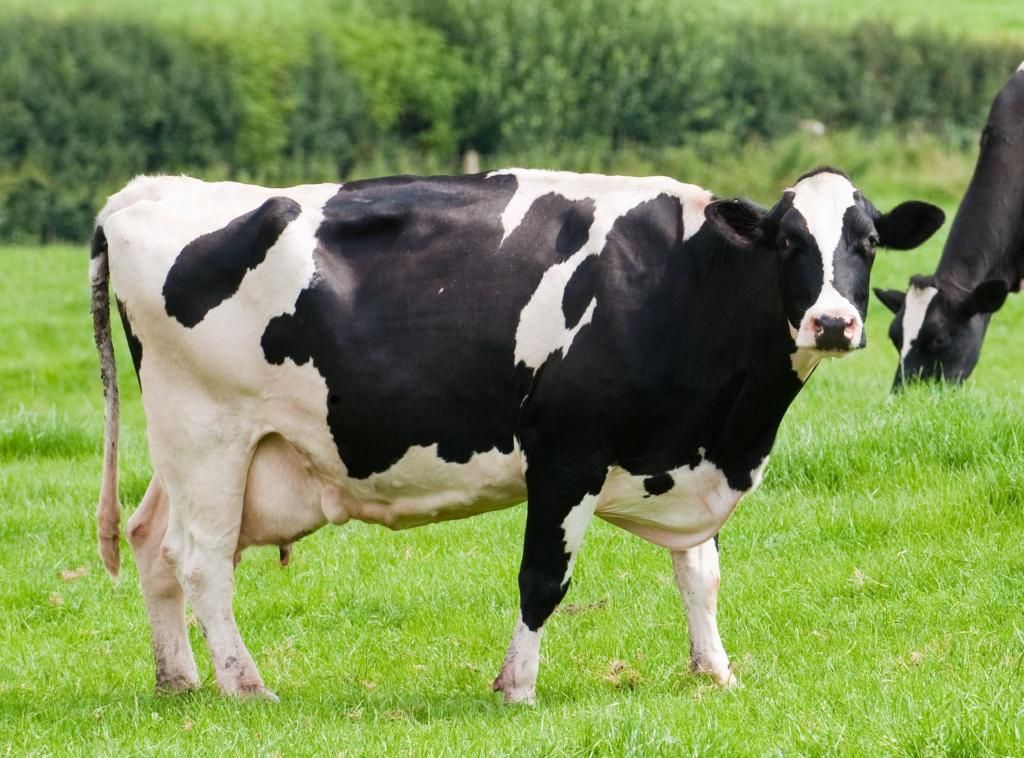
Sheep
Sheep refers to the sheep genus. Some are domesticated, and some are wild. A sheep is an individual of any of the eight woolly mammal species that comprise the genus ovis. Sheep are members of the order Artiodactyla (even-toed hooved animals). All sheep are ovids (members of the family Ovidae). The domestic sheep is thought to descend from the wild Moufflon of central and south west Asia. In South Africa domesticated sheep breeds are very well adapted to the barren parts of the Sub Continent.
The following illustration gives the full scientific classification of the sheep genus: Dohne sheep.
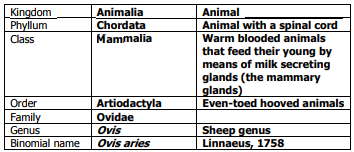
Here are eight examples of the sheep species:
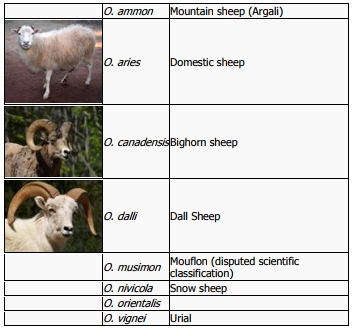
Goat
A goat is a mammal in the genus Capra which consists of nine species. The domestic goat (Capra aegagrus hircus) is a domesticated subspecies of the wild goat. Goats are members of the family Capridae and members of the Order Artiodactyla (even-toed hooved animals) just like cattle and sheep.
The domestic goat: Scientific classification:
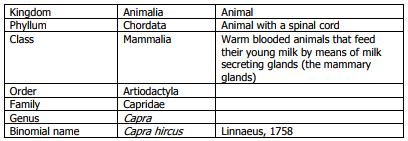
There are other animals (species) of the genus Capra that are domesticated and used in farming. A few examples are:

The Pig
Pigs are native to Eurasia and are collectively grouped under the genus Sus within the Suidae family. They have been domesticated and raised as livestock by some people for meat as well as leather. Their bristle (hairs) are also traditionally used for brushes. Pigs are omnivores (they consume both plants and animals).
The domestic pig: Scientific classification
Some further species of pigs are shown below:
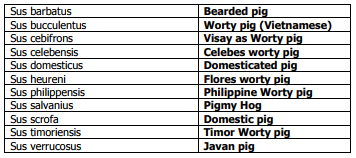
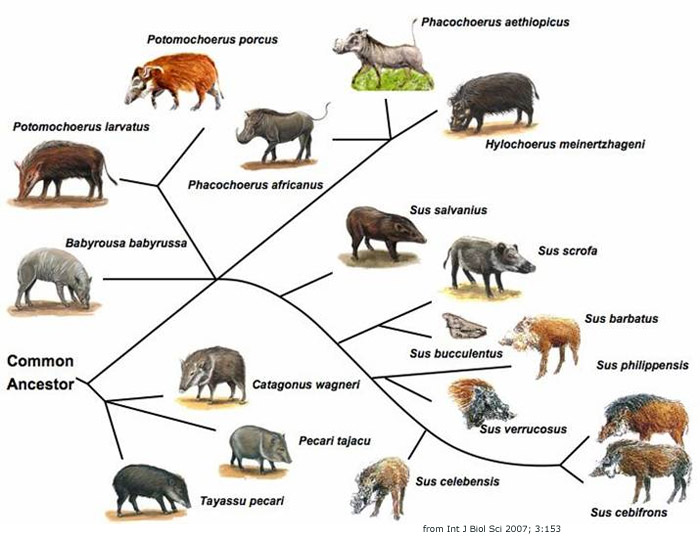
The Chicken
A chicken (Gallus gallus) is a domesticated bird. It is believed to be descended from the wild Asian Red Jungle fowl. Chickens are the most common bird in the world. The population in 2003 was 24 billion.
Scientific classification:

Ostrich
The ostrich (Struthio camelus) is a flightless bird native to Africa. It is the only living species of its family, Struthionidae, and its genus, Struthio. They are distinct in their appearance, with a long neck and legs and the ability to run at speeds of about 65 km / hour. Ostriches are considered the largest living species of bird and are found all over the world. The scientific name for the ostrich is from Greek for "sparrow camel".
Scientific classification:

Dog
The dog is a canine mammal of the order Carnivore. Dogs were first domesticated from wolves at least 15 000 years ago. Below is the scientific classification of the breed the Labrador within the subspecie familiaris.
Scientific classification:
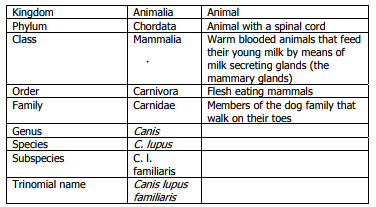
The Cat
The cat, also called the domestic cat or house cat is a small feline carnivorous mammal of the subspecies Felis silvestris. Below is the scientific classification of the domesticated cat.
Scientific classification:
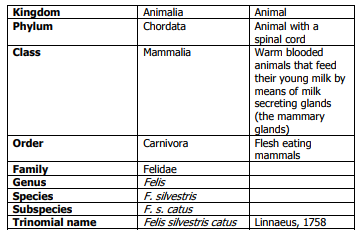
The Dove
There are about 308 species of doves in the order Columbiformes. The terms “dove” and “pigeon” are used interchangeably although smaller species are more likely to be called doves. Below is the Scientific classification of the Peaceful Dove (Geopelia placida). There are many species under the genus Columba.
The family is usually divided into five subfamilies. Each subfamily has several genus and specie names.
Scientific classification:

The Equidae
This is the Family of horse-like animals. It is sometimes known as the horse family. Apart from the horses, other equids include the donkey, the three Zebras and the Onager. These fall in the genus Equus. Below is the scientific classification of Equids.
Scientific classification:
Below is a list of some of the Equid species:

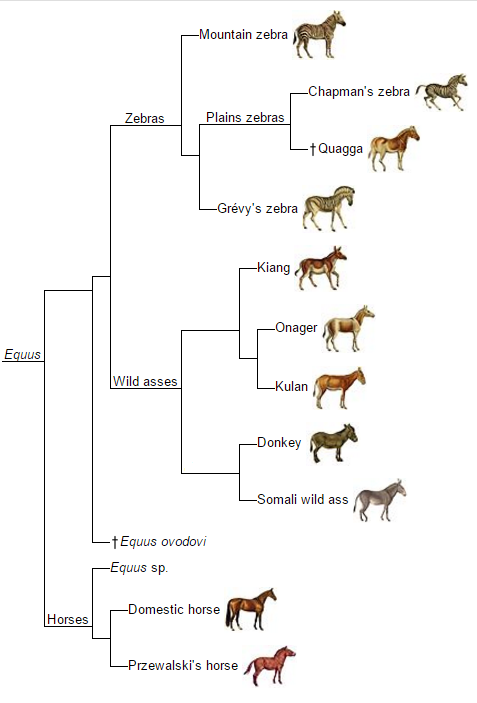
Conclusion
The scientific classification system generally uses the external anatomy and morphology of the animal to differentiate between types of animals. It is therefore very important that the learner understand the basic method of scientific classification. They should be able to identify the basic differences in the external anatomy of farm animals. Of particular importance for domesticated animals (apart from the birds) is the distinction between the even-toed and odd-toed hooved animals.
Some of the anatomical features which assist in the classification of animals include:
- Whether they have a backbone
- Whether they give birth to live young
- Whether they suckle their young
- What they eat (i.e. what type of stomach do they have)
- What type of covering they have on their bodies (hair or feathers)
- What their claws, nails or hooves look like
- What their teeth look like
- The posture of their feet when walking
